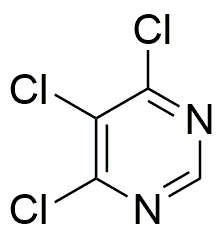4,5,6-Trichloropyrimidine is widely utilized in research focused on:
- Pharmaceutical Development: This compound serves as a key intermediate in the synthesis of various pharmaceuticals, particularly in the development of antiviral and anticancer agents, enhancing the efficacy of treatments.
- Agricultural Chemicals: It is used in the formulation of herbicides and fungicides, providing effective solutions for crop protection and pest management, which is crucial for increasing agricultural productivity.
- Material Science: The compound is employed in the creation of specialized polymers and resins, contributing to the development of materials with enhanced durability and chemical resistance.
- Biochemical Research: Researchers utilize it as a building block for synthesizing nucleoside analogs, aiding in studies related to genetic material and cellular processes.
- Analytical Chemistry: It is used as a reference standard in various analytical methods, ensuring accuracy and reliability in the detection and quantification of similar compounds.
Informations générales
Propriétés
Sécurité et réglementation
Applications
4,5,6-Trichloropyrimidine is widely utilized in research focused on:
- Pharmaceutical Development: This compound serves as a key intermediate in the synthesis of various pharmaceuticals, particularly in the development of antiviral and anticancer agents, enhancing the efficacy of treatments.
- Agricultural Chemicals: It is used in the formulation of herbicides and fungicides, providing effective solutions for crop protection and pest management, which is crucial for increasing agricultural productivity.
- Material Science: The compound is employed in the creation of specialized polymers and resins, contributing to the development of materials with enhanced durability and chemical resistance.
- Biochemical Research: Researchers utilize it as a building block for synthesizing nucleoside analogs, aiding in studies related to genetic material and cellular processes.
- Analytical Chemistry: It is used as a reference standard in various analytical methods, ensuring accuracy and reliability in the detection and quantification of similar compounds.
Documents
Fiches de données de sécurité (FDS)
La FDS fournit des informations de sécurité complètes sur la manipulation, le stockage et l’élimination du produit.
Spécifications du produit (PS)
Le PS fournit une description complète des propriétés du produit, notamment sa composition chimique, son état physique, sa pureté et les exigences de stockage. Il détaille également les plages de qualité acceptables et les applications prévues du produit.
Certificats d'analyse (COA)
Recherchez des certificats d'analyse (COA) en saisissant le numéro de lot du produit. Les numéros de lot et de lot se trouvent sur l'étiquette d'un produit, après les mots « Lot » ou « Lot de fabrication ».
Numéro de catalogue
Numéro de lot/série
Certificats d'origine (COO)
Ce certificat d'exploitation confirme le pays dans lequel le produit a été fabriqué, et détaille également les matériaux et composants utilisés et s'il est issu de sources naturelles, synthétiques ou autres sources spécifiques. Ce certificat peut être requis pour les douanes, le commerce et la conformité réglementaire.
Numéro de catalogue
Numéro de lot/série
Fiches de données de sécurité (FDS)
La FDS fournit des informations de sécurité complètes sur la manipulation, le stockage et l’élimination du produit.
DownloadSpécifications du produit (PS)
Le PS fournit une description complète des propriétés du produit, notamment sa composition chimique, son état physique, sa pureté et les exigences de stockage. Il détaille également les plages de qualité acceptables et les applications prévues du produit.
DownloadCertificats d'analyse (COA)
Recherchez des certificats d'analyse (COA) en saisissant le numéro de lot du produit. Les numéros de lot et de lot se trouvent sur l'étiquette d'un produit, après les mots « Lot » ou « Lot de fabrication ».
Numéro de catalogue
Numéro de lot/série
Certificats d'origine (COO)
Ce certificat d'exploitation confirme le pays dans lequel le produit a été fabriqué, et détaille également les matériaux et composants utilisés et s'il est issu de sources naturelles, synthétiques ou autres sources spécifiques. Ce certificat peut être requis pour les douanes, le commerce et la conformité réglementaire.


